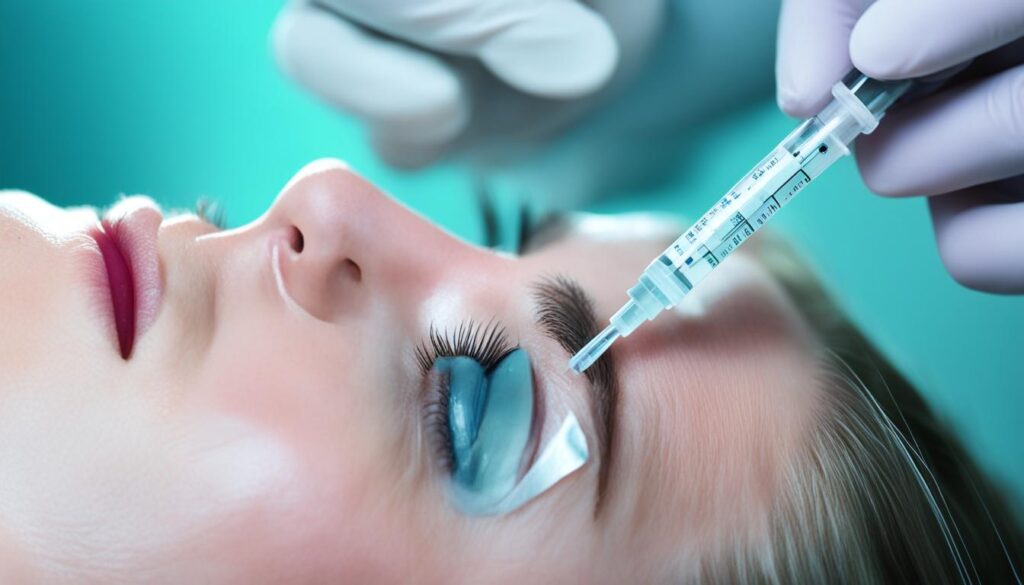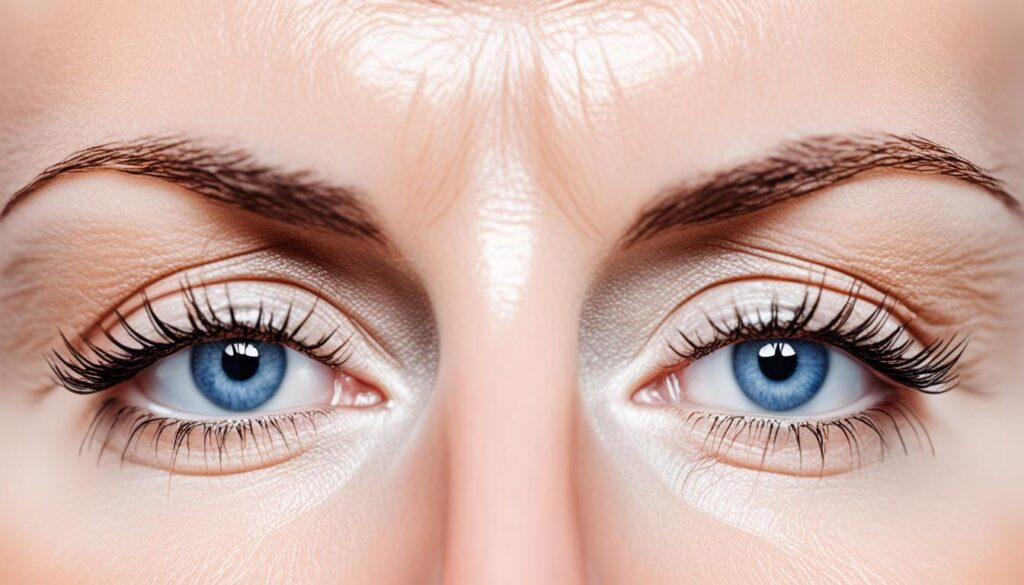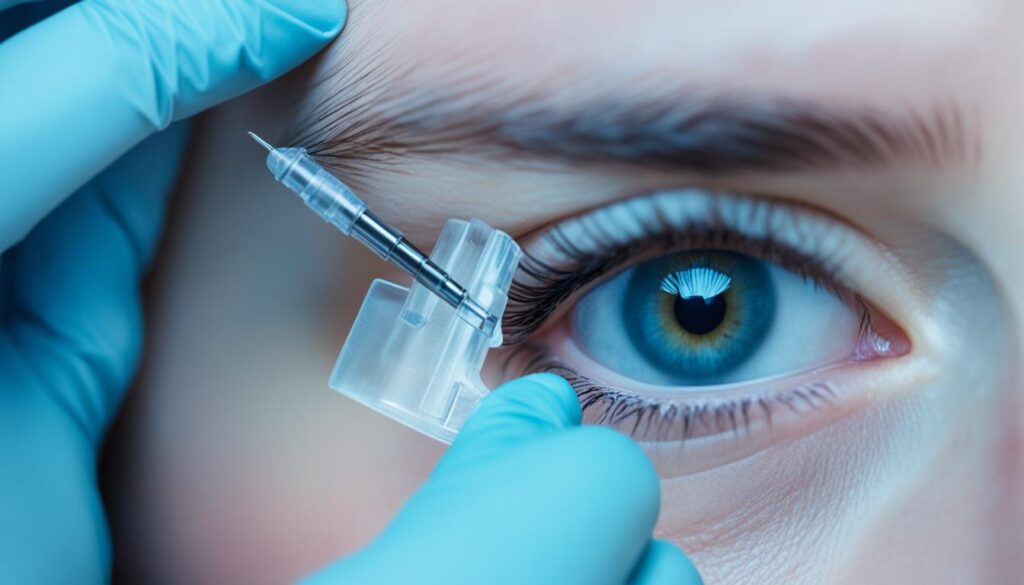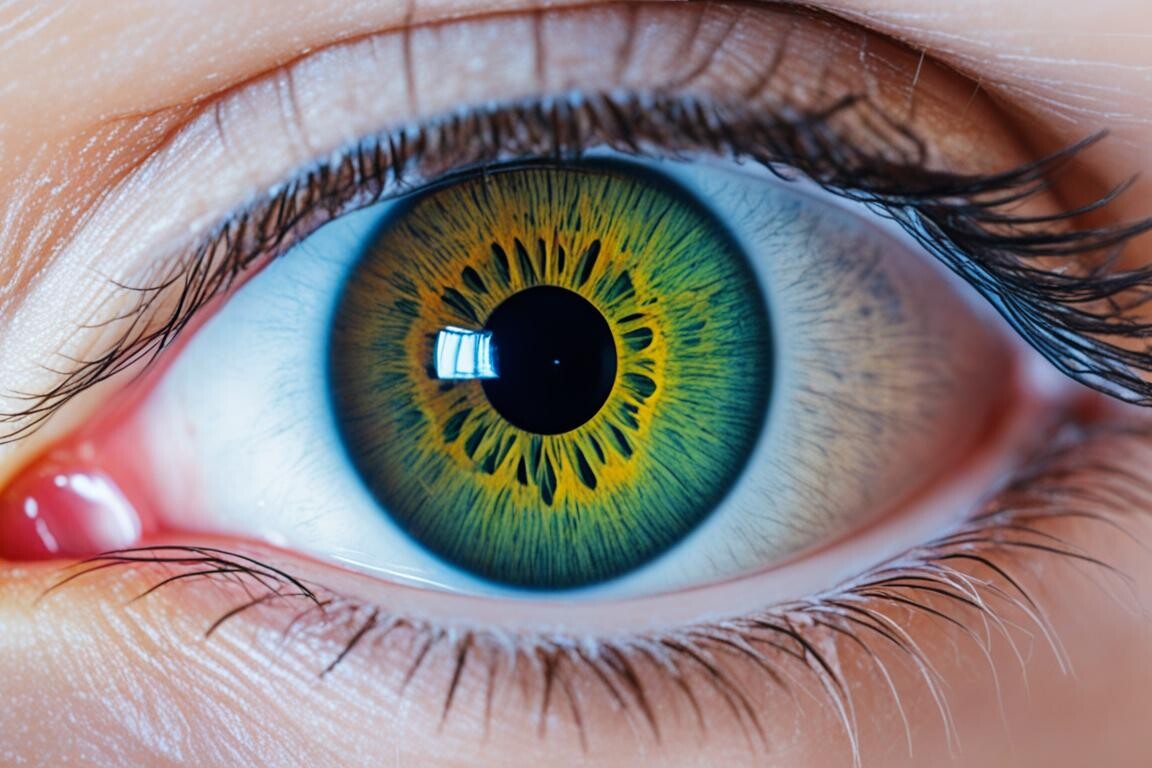Benign essential blepharospasm is a neurological disorder characterized by involuntary muscle spasms and contractions of the muscles around the eyes. If you or someone you know is affected by this condition, finding effective treatment options is essential for providing relief and improving quality of life.
In this article, we will explore various treatment options for benign essential blepharospasm and discuss their effectiveness. From botulinum toxin A injections to surgical approaches, understanding the available treatments can help you make informed decisions about managing this condition.
Stay tuned to learn about the latest research, potential future developments, and how these treatments can offer significant relief and improved quality of life for individuals with benign essential blepharospasm.
Key Takeaways:
- Treatment options for benign essential blepharospasm are crucial in providing relief and improving quality of life.
- Botulinum toxin A injections are a highly effective treatment for blepharospasm, providing significant relief from involuntary muscle spasms.
- Surgical approaches, such as protractor myectomy and neurectomy, may be considered when other treatments are ineffective.
- Oral drug therapy can be used for treatment, but results are often moderate and temporary.
- Ongoing research and clinical trials aim to enhance treatment outcomes and develop new strategies for managing benign essential blepharospasm in the future.
Table of Contents
ToggleBotulinum Toxin A Injections for Blepharospasm
Botulinum toxin A injections have been established as a highly effective treatment for blepharospasm. This neurotoxin is injected locally into the orbicularis oculi muscle, causing muscular paralysis by interfering with the release of acetylcholine. The injections relieve the involuntary muscle spasms and provide significant relief for patients with blepharospasm.
Botulinum toxin A, commonly known as Botox, is a purified form of the botulinum toxin that selectively targets the muscles responsible for the spasm. By blocking the release of acetylcholine, a neurotransmitter that triggers muscle contractions, the injections effectively reduce muscle activity and provide relief from the involuntary spasms.
The procedure involves administering multiple small injections directly into the affected muscles. The precise dosage and injection sites are determined based on the individual’s symptoms and response to previous treatments. The injections are typically well-tolerated and do not require anesthesia.
The effects of botulinum toxin A injections for blepharospasm typically last for several months. As the effects wear off, muscle spasms may gradually return, and repeat injections are necessary to maintain the therapeutic benefit. Ongoing treatment with botulinum toxin A injections has been shown to significantly improve the quality of life for individuals with blepharospasm.
Benefits of Botulinum Toxin A Injections:
- Effective relief from blepharospasm symptoms
- Reduction in involuntary muscle spasms
- Improved control over eyelid movements
- Enhanced quality of life
Botulinum toxin A injections are considered the first-line treatment for blepharospasm due to their effectiveness and minimal side effects. However, it is important to note that individual responses may vary, and the treatment’s specific effects should be discussed with a qualified healthcare professional.
In addition to blepharospasm, botulinum toxin A injections have also been used to treat various other medical conditions, including cervical dystonia, hyperhidrosis, and chronic migraines.

By providing targeted relief from blepharospasm symptoms, botulinum toxin A injections offer an effective treatment option that allows individuals to regain control over their eyelid movements and improve their overall quality of life.
Effects of Botulinum Toxin A Injections on Tear Function and Ocular Surface
A study investigated the effects of botulinum toxin A injections on tear function and the morphology of the ocular surface in patients with blepharospasm and dry eye syndrome. Botulinum toxin A injections are a highly effective treatment for blepharospasm, providing relief from the involuntary muscle spasms.
However, the study found that while all patients experienced relief from blepharospasm, only a few noticed an improvement in dry eye symptoms. The tear break-up time, which measures the stability of the tear film, was found to increase after injections. This indicates that the tear function improved, leading to better ocular surface protection.
Effects of Botulinum Toxin A Injections:
- Relief from blepharospasm
- Improved tear function
- Increased tear break-up time
- Better ocular surface protection

Despite these positive effects on tear function and ocular surface, the Schirmer test measurements, which assess tear production, were reduced after the injections. This suggests that the tear production decreased after the treatment. However, further research is needed to understand the underlying mechanism behind this reduction in tear production.
The study also performed impression cytology, which examines the morphology of conjunctival cells. The results showed no definite change in conjunctival cell morphology after botulinum toxin A injections.
Conventional Treatment for Essential Blepharospasm Using Dysport
The conventional treatment for essential blepharospasm involves the use of Dysport, a type of botulinum toxin A. Dysport injections are administered to specific areas of the orbicularis muscle to provide relief from the involuntary muscle contractions associated with blepharospasm. This treatment has proven to be effective in relieving blepharospasm symptoms and improving the quality of life for individuals with this condition.
Dysport is a well-established brand in the field of medical aesthetics, known for its application in various therapeutic areas. By targeting the overactive muscles responsible for the involuntary spasms, Dysport helps relax the muscles and reduce the severity of blepharospasm symptoms. The procedure is typically performed by trained healthcare professionals, ensuring safe and accurate administration of the injections.
How does Dysport work?
Dysport contains a purified form of botulinum toxin type A, which targets the nerve endings that control muscle activity. When injected into the affected muscles, Dysport blocks the release of acetylcholine, a neurotransmitter responsible for muscle contractions. By interrupting the signals between the nerves and muscles, Dysport effectively inhibits the involuntary spasms associated with blepharospasm.
The effects of Dysport injections typically last for several months, and repeat treatments may be necessary to maintain optimal results. The exact dosage and frequency of injections may vary depending on individual needs and medical recommendations from a healthcare professional.
Potential side effects and considerations
While Dysport is generally well-tolerated, there are potential side effects associated with the treatment. These can include localized pain, bruising, swelling, and temporary weakness of the surrounding muscles. It is important to discuss potential risks and benefits with a healthcare professional before undergoing Dysport treatment for blepharospasm.

Oral Drug Therapy for Benign Essential Blepharospasm
When it comes to treating benign essential blepharospasm, oral drug therapy is a common approach. Approximately one-third of individuals with this condition find relief through the use of oral medications. Two types of drugs that are commonly prescribed for blepharospasm are anticholinergic drugs and dopamine depleters.
Anticholinergic drugs work by blocking the action of acetylcholine, a neurotransmitter that plays a role in muscle contractions. By inhibiting acetylcholine, these drugs help reduce the involuntary muscle spasms associated with blepharospasm. Some commonly used anticholinergic drugs for this condition include:
- Tetrabenazine
- Clonazepam
- Trihexyphenidyl
- Diazepam
- Baclofen
Dopamine depleters, on the other hand, work by reducing the levels of dopamine, a neurotransmitter that can contribute to excessive muscle contractions. These drugs are often prescribed as a secondary option when anticholinergic drugs are not fully effective. They can be used in combination with anticholinergic drugs to enhance the overall treatment response.
It’s important to note that while oral drug therapy can provide relief for individuals with benign essential blepharospasm, the results are often moderate and temporary. Different individuals may respond differently to these medications, and finding the right dosage and combination of drugs may require some trial and error.
Ultimately, the goal of oral drug therapy is to reduce the frequency and severity of muscle spasms, improving the overall quality of life for individuals with benign essential blepharospasm. However, it’s important to consult with a healthcare professional to determine the most appropriate medication and dosage for your specific condition.

Surgical Approaches for Benign Essential Blepharospasm
In cases where drug therapy is ineffective, surgical approaches may be considered. These surgical interventions aim to provide long-term relief from symptoms and improve the quality of life for individuals with benign essential blepharospasm.
Protractor Myectomy
One surgical option is protractor myectomy, where the affected eyelid muscles are partially or completely removed. This procedure involves the excision of the protractor muscles, which are responsible for eyelid closure. By eliminating or reducing these muscles, the involuntary spasms and contractions can be significantly minimized.
Neurectomy
Neurectomy, another surgical procedure, focuses on removing sections of the facial nerve branches leading to the orbicularis oculi muscle. This aims to interrupt the abnormal nerve signals causing the muscle contractions. However, as neurectomy poses a higher risk of complications and potential facial weakness, it is rarely used as a surgical approach for benign essential blepharospasm.
Both protractor myectomy and neurectomy require careful consideration and evaluation by an experienced oculoplastic surgeon to determine the appropriateness and potential benefits for each individual case.

| Surgical Approach | Procedure | Benefits |
|---|---|---|
| Protractor Myectomy | Partial or complete removal of affected eyelid muscles | Significant reduction in muscle spasms and contractions |
| Neurectomy | Removal of sections of facial nerve branches leading to the orbicularis oculi muscle | Interrupts abnormal nerve signals causing muscle contractions |
Prevalence and Demographics of Benign Essential Blepharospasm
Benign essential blepharospasm is a neurological disorder that primarily affects women, with an average age of onset around 56 years. It is estimated that approximately 2,000 new cases of benign essential blepharospasm are diagnosed each year in the United States. In the general population, the prevalence of this condition is around 5 per 100,000 individuals.
While benign essential blepharospasm can occur in both genders, it tends to be more prevalent in women. The exact reasons for this gender difference are not yet fully understood. However, hormonal factors and genetic predisposition are believed to play a role in the higher prevalence among women.
Demographics
Demographically, benign essential blepharospasm can affect individuals of any ethnic background. However, research has shown that certain populations may have a higher prevalence of this condition.
In a study conducted in India, it was found that benign essential blepharospasm was more prevalent among individuals of Indian descent when compared to other ethnic groups. This suggests that there may be genetic and environmental factors specific to certain populations that contribute to the development of this disorder.
The prevalence of benign essential blepharospasm also tends to increase with age. As mentioned earlier, the average age of onset is around 56 years. However, it can occur at any age, with some cases reported in individuals as young as their twenties.
Understanding the prevalence and demographics of benign essential blepharospasm provides valuable insights into the impact of this condition on different populations. It also highlights the need for further research to better understand the underlying causes and develop targeted treatment strategies.

Key Points:
- Benign essential blepharospasm primarily affects women.
- The average age of onset is around 56 years.
- The prevalence of benign essential blepharospasm is around 5 per 100,000 individuals in the general population.
- Genetic and hormonal factors may contribute to the higher prevalence among women.
- Demographically, individuals of Indian descent may have a higher prevalence of benign essential blepharospasm.
- The condition can occur at any age, with cases reported in individuals as young as their twenties.
Similar Disorders and Differential Diagnosis
Benign essential blepharospasm shares symptoms with other disorders such as Meige syndrome, Bell’s palsy, dystonia, and hemifacial spasm. It is crucial to perform a differential diagnosis to distinguish these disorders based on their specific symptoms and clinical presentation. This helps in accurately identifying the underlying condition and determining the most appropriate treatment approach.
Meige Syndrome
Meige syndrome, also known as cranial dystonia, is a rare neurological disorder characterized by involuntary muscle contractions affecting the face, including the eyelids and mouth. In addition to blepharospasm, individuals with Meige syndrome may experience involuntary movements of the jaw, tongue, or neck. The symptoms of Meige syndrome can be similar to benign essential blepharospasm, but the involvement of other facial muscles distinguishes these two conditions.
Bell’s Palsy
Bell’s palsy is a condition characterized by sudden paralysis or weakness of the facial muscles, typically on one side of the face. While blepharospasm can occur as a result of facial nerve dysfunction in both Bell’s palsy and benign essential blepharospasm, Bell’s palsy is distinguished by the sudden onset of facial weakness or paralysis. In contrast, benign essential blepharospasm is typically characterized by repetitive and involuntary eye blinking or spasms.
Dystonia
Dystonia is a movement disorder characterized by involuntary muscle contractions that cause abnormal, repetitive movements or posture. Blepharospasm can be a symptom of certain forms of dystonia, such as focal dystonia or segmental dystonia. It is important to differentiate between benign essential blepharospasm and dystonic blepharospasm to establish an accurate diagnosis and guide appropriate treatment decisions.
Hemifacial Spasm
Hemifacial spasm is a condition characterized by involuntary twitching or contractions of the muscles on one side of the face. While both hemifacial spasm and benign essential blepharospasm involve involuntary muscle contractions and spasms of the facial muscles, hemifacial spasm typically affects a broader area of the face beyond the eyelids. Additionally, hemifacial spasm is often caused by compression or irritation of the facial nerve, whereas benign essential blepharospasm is considered a primary dystonia.
Distinguishing between these similar disorders is crucial for an accurate diagnosis and appropriate treatment. Healthcare professionals utilize a combination of clinical evaluation, medical history, and diagnostic tests to differentiate these conditions based on their specific symptoms, underlying causes, and patterns of muscle involvement.
| Disorder | Characteristic Symptoms |
|---|---|
| Meige Syndrome | Involuntary muscle contractions affecting the face |
| Bell’s Palsy | Sudden paralysis or weakness of facial muscles, typically on one side |
| Dystonia | Involuntary muscle contractions causing abnormal movements or posture |
| Hemifacial Spasm | Involuntary twitching or contractions of muscles on one side of the face |
Causes and Mechanisms of Benign Essential Blepharospasm
The exact cause of benign essential blepharospasm is still unknown, but researchers believe that it may be multifactorial, involving various underlying factors. A dysfunction of the basal ganglia, a region of the brain responsible for motor control, is thought to play a role in the development of benign essential blepharospasm (BEB). Genetic and environmental factors may also contribute to the condition.
Studies have shown that abnormalities in the pathways connecting the basal ganglia to the thalamus and cerebral cortex can lead to the involuntary muscle contractions characteristic of BEB. These abnormalities can disrupt the physiological balance of neurotransmitters, such as dopamine and acetylcholine, which regulate muscle movement.
Genetic factors may also contribute to the development of BEB. Some studies have identified specific genetic mutations that are more prevalent in individuals with BEB compared to the general population. These mutations may affect the functioning of certain proteins involved in neuronal communication and muscle control.
Furthermore, environmental factors such as prolonged exposure to environmental toxins or certain medications have been suggested as potential triggers for the development or worsening of benign essential blepharospasm. However, more research is needed to establish a definitive causal relationship between these factors and the onset of BEB.
While the exact mechanisms of BEB are still being investigated, understanding the potential causes and underlying pathways involved in the development of this condition is crucial for developing targeted treatment strategies and improving outcomes for patients.
| Potential Causes of Benign Essential Blepharospasm | Possible Mechanisms |
|---|---|
| Dysfunction of the basal ganglia | Impaired neurotransmitter balance |
| Genetic factors | Mutations affecting neuronal communication |
| Environmental factors | Exposure to toxins or certain medications |
Clinical Trials and Research in Benign Essential Blepharospasm
Various clinical trials and research studies are being conducted to explore new treatment approaches and further understand the underlying mechanisms of benign essential blepharospasm. These studies aim to improve treatment outcomes and quality of life for individuals with benign essential blepharospasm (BEB).
LATEST CLINICAL TRIALS
Several clinical trials are currently underway to evaluate the efficacy and safety of different treatment options for BEB. These trials involve the participation of individuals with BEB who are willing to contribute to the advancement of medical knowledge and the development of improved therapeutic strategies. Some of the ongoing clinical trials include:
- A randomized controlled trial comparing the efficacy of botulinum toxin A injections with oral medication in the management of BEB.
- An observational study investigating the long-term outcomes and side effects of surgical approaches for BEB, such as protractor myectomy and neurectomy.
- A multicenter trial assessing the impact of comprehensive multidisciplinary care on the quality of life of individuals with BEB, including a combination of medical, surgical, and rehabilitative interventions.
These clinical trials play a vital role in expanding our knowledge of BEB and shedding light on the effectiveness of different treatment modalities. By participating in these trials, individuals with BEB can contribute to the development of evidence-based guidelines and improved therapies.
CURRENT RESEARCH FOCUS
Researchers are actively investigating the underlying mechanisms of BEB to develop targeted therapies that can alleviate symptoms and improve the quality of life for individuals living with this condition. Some of the current areas of research include:
- Exploring the role of genetic factors in the development and progression of BEB.
- Investigating the impact of environmental triggers on the onset and severity of BEB symptoms.
- Assessing the neurochemical imbalances that contribute to the muscle spasms observed in BEB.
- Developing novel approaches for delivering botulinum toxin A injections, such as sustained-release formulations, to improve treatment efficacy and reduce the frequency of injections.
Through these research endeavors, scientists and clinicians strive to uncover new insights into the pathophysiology of BEB and facilitate the development of innovative treatment options.
LATEST RESEARCH FINDINGS
| Research Finding | Implication |
|---|---|
| Study shows a potential link between BEB and basal ganglia dysfunction. | Understanding the role of the basal ganglia can lead to targeted therapies that address the root cause of BEB. |
| Research suggests a genetic predisposition to BEB. | Identifying specific genetic markers can help with early detection and personalized treatment approaches. |
| Pilot study explores the use of non-invasive brain stimulation techniques in alleviating BEB symptoms. | Non-invasive approaches like transcranial magnetic stimulation may provide a safe and effective alternative to traditional treatment methods. |
These research findings highlight the progress being made in understanding and managing BEB. As researchers continue to uncover new insights, the future looks promising for individuals living with this challenging neurological disorder.
Potential Future Developments in Benign Essential Blepharospasm Treatment
Ongoing research and advancements in the field of neurology hold promise for future developments in the treatment of benign essential blepharospasm. As scientists and medical professionals delve deeper into understanding the underlying mechanisms of this condition, new therapies and treatment modalities are being explored. These advancements aim to offer improved outcomes and long-term relief for individuals with benign essential blepharospasm.
One potential future development in the treatment of benign essential blepharospasm is the use of neuroprotective agents. These agents, such as antioxidants and anti-inflammatory drugs, may help protect the nerves and muscles involved in the disorder, potentially slowing down its progression.
Genetic research is also shedding light on the potential of personalized medicine in treating benign essential blepharospasm. By identifying specific genetic markers associated with the condition, doctors may be able to tailor treatment plans to each individual, increasing the effectiveness and reducing the risk of adverse effects.
Advancements in imaging technology are also expected to contribute to future developments in the treatment of benign essential blepharospasm. The ability to visualize and map the affected areas of the brain and eye muscles with greater precision can help guide targeted therapeutic interventions, such as more accurate placement of botulinum toxin injections.
Furthermore, non-invasive techniques such as transcranial magnetic stimulation (TMS) and transcranial direct current stimulation (tDCS) are being explored as potential treatment options. These methods aim to modulate the brain’s electrical activity and may provide relief from blepharospasm symptoms without the need for invasive procedures or medications.
Potential Future Developments in Benign Essential Blepharospasm Treatment
| Potential Future Developments | Description |
|---|---|
| Neuroprotective Agents | Exploring the use of antioxidants and anti-inflammatory drugs to protect nerves and muscles involved in benign essential blepharospasm. |
| Personalized Medicine | Identifying genetic markers associated with the condition to tailor treatment plans on an individual basis. |
| Advancements in Imaging Technology | Utilizing advanced imaging techniques to visualize and map affected areas for more precise interventions. |
| Non-Invasive Techniques | Exploring the potential of transcranial magnetic stimulation (TMS) and transcranial direct current stimulation (tDCS) as non-invasive treatment options. |
Conclusion
Benign essential blepharospasm is a challenging neurological disorder that causes involuntary muscle spasms and contractions around the eyes. However, with the various treatment options available, significant relief can be achieved for individuals with this condition.
Botulinum toxin A injections have emerged as an effective treatment for reducing muscle spasms and providing relief for patients with benign essential blepharospasm. By targeting the orbicularis oculi muscle, these injections paralyze the muscles and alleviate the involuntary contractions. Additionally, surgical approaches such as protractor myectomy and neurectomy may be considered for cases where drug therapy is ineffective.
Ongoing research and clinical trials in the field of benign essential blepharospasm offer hope for the development of new and improved treatment strategies. These endeavors aim to further understand the underlying mechanisms of the disorder and explore novel therapies that can enhance treatment outcomes and improve the quality of life for affected individuals. With advancements in the field of neurology, the future holds promise for more effective and long-lasting treatments for benign essential blepharospasm.
FAQ
What is benign essential blepharospasm?
Benign essential blepharospasm is a neurological disorder characterized by involuntary muscle spasms and contractions of the muscles around the eyes.
What are the effective treatments for benign essential blepharospasm?
Effective treatments for benign essential blepharospasm include botulinum toxin A injections, oral drug therapy, and surgical approaches.
How do botulinum toxin A injections work for blepharospasm?
Botulinum toxin A injections are injected into the orbicularis oculi muscle and cause muscular paralysis by interfering with the release of acetylcholine, providing relief from involuntary muscle spasms.
Do botulinum toxin A injections improve tear function and the ocular surface?
While botulinum toxin A injections provide relief from blepharospasm, they may only have a minimal impact on dry eye symptoms and tear function.
What is the conventional treatment for essential blepharospasm?
The conventional treatment for essential blepharospasm involves the use of Dysport, a type of botulinum toxin A, which is injected into specific areas of the orbicularis muscle to relieve involuntary muscle contractions.
Are there oral medications for benign essential blepharospasm?
Yes, oral medications such as anticholinergic drugs and dopamine depleters like tetrabenazine are commonly used, but the results of drug therapy are often moderate and temporary.
What are the surgical approaches for benign essential blepharospasm?
Surgical approaches for benign essential blepharospasm include protractor myectomy, where the eyelid muscles are partially or completely removed, and neurectomy, which involves removing sections of the facial nerve branches leading to the orbicularis oculi.
Who does benign essential blepharospasm affect?
Benign essential blepharospasm is more commonly seen in women, with an average age of onset around 56. It affects approximately 2,000 new cases per year in the United States, with a prevalence of around 5 per 100,000 individuals in the general population.
What are some similar disorders to benign essential blepharospasm?
Similar disorders to benign essential blepharospasm include Meige syndrome, Bell’s palsy, dystonia, and hemifacial spasm. Differential diagnosis is necessary to distinguish these disorders based on specific symptoms and clinical presentation.
What causes benign essential blepharospasm?
The exact cause of benign essential blepharospasm is unknown, but researchers believe it may be multifactorial, involving dysfunction of the basal ganglia, genetic factors, and environmental factors.
What research is being done for benign essential blepharospasm?
Various clinical trials and research studies are being conducted to explore new treatment approaches and further understand the underlying mechanisms of benign essential blepharospasm, with the aim of improving treatment outcomes and quality of life.
Are there potential future developments in the treatment of benign essential blepharospasm?
Ongoing research and advancements in the field of neurology may lead to future developments in the treatment of benign essential blepharospasm, offering improved outcomes and long-term relief for individuals with this condition.
Source Links
About The Author

This article is medically reviewed by Dr. Chandril Chugh, Board-Certified Neurologist, providing expert insights and reliable health information.
Dr. Chandril Chugh is a U.S.-trained neurologist with over a decade of experience. Known for his compassionate care, he specializes in treating neurological conditions such as migraines, epilepsy, and Parkinson’s disease. Dr. Chugh is highly regarded for his patient-centered approach and dedication to providing personalized care.
→ Book a consultation to discover which remedies suit your needs best.




